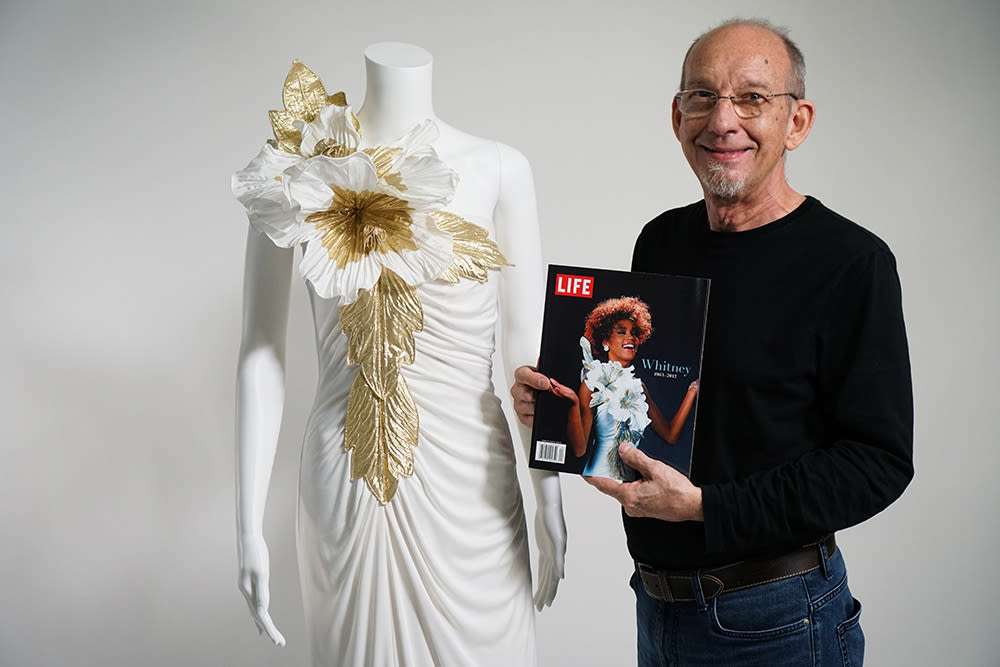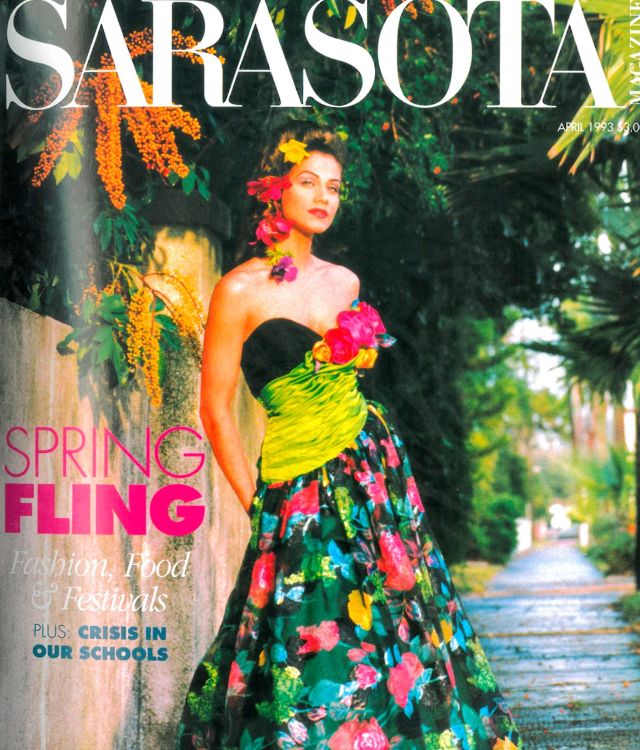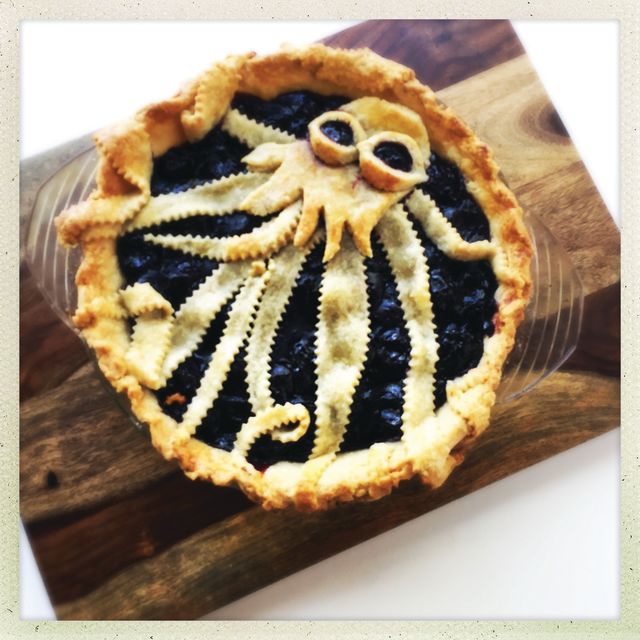From a Fashion Empire to a Cherry Pie, Eugene Stutzman Lives to Create

Eugene Stutzman with a dress he designed for the late Whitney Houston, worn by both Houston and actress Sarah Jessica Parker.
Image: Courtesy Photo
Eugene Stutzman’s cherry pie recipe is the same one he learned at his mother’s side while growing up in Berlin, Ohio, Amish capital of the United States, with one slight variation. While his mother used plain shortening, Stutzman uses an artificial but tasty upgrade: butter-flavored Crisco. “That’s what Loretta Lynn uses,” he says, handing me a bright red cherry pitter and towel and encouraging me to get to work. If it’s all right with Loretta Lynn, it’s all right with Stutzman.
I place six dark purple cherries into Stutzman’s pitter—he loves kitchen gadgets—and crush down to pop out the little stones inside the fruit. As I finish, Stutzman adds the hollowed-out cherries to a deep steel pan and turns up the heat.
Stutzman, 66, is many things—a former fashion designer to the stars, a lifelong Mennonite who’s active in his church, a manufacturer of decorative pipe organ facades that hang in churches and residences around the country. And, as one of his friends put it to me, “He makes a delicious pie.” Stutzman grew up baking with his mother during an era when boys, especially Amish boys, were not encouraged to take up cooking. When Stutzman was 7, a neighbor told Stutzman’s mother, “Eugene will make a good wife someday.”
“I’ve always been gender nonconforming,” Stutzman says as our fruit starts to sizzle. Stutzman—who’s wearing a black T-shirt tucked into loose jeans, with his gray hair cut short and a soul patch on his chin—wanders over to a nearby table and picks up a foam mannequin head to show me the other project that he’s working on this morning.
He’s designing a series of elaborate paper headdresses to spruce up the bald pates of dozens of mannequins that will be clothed in his dresses during a fashion show at Goshen Theater in Goshen, Indiana. The show—part runway strut, part museum installation—will feature 60 dresses designed by Stutzman and his late partner, Alexander Wallace, under the label Eugene Alexander in the ’80s and ’90s. During the company’s heyday, Stutzman and Wallace’s designs were worn by Whitney Houston, Elizabeth Taylor, Jane Fonda and dozens more—including Loretta Lynn.

A Eugene Alexander dress was featured on the cover of the April 1993 issue of Sarasota Magazine. The issue also included a profile of Stutzman and Wallace and their company. (Photo by Mary McCulley.)
Image: Sarasota Magazine
The couple launched the company after Wallace landed a part as an extra in the film Honky Tonk Freeway (the movie, which was made in Sarasota, is best known locally for the crew blowing up the I-75 bridge over Palmer Road to shoot the climax). At the time, Stutzman, who also learned to sew from his mother, was designing costumes for The Players and creating wall hangings. A costume designer working on the film saw his work and told him, “You should make a line and take it to New York.”
So he and Wallace did. The couple formed Eugene Alexander in 1981 and rented studio space on Seventh Avenue. “New Yorkers are real snobs about buildings,” Stutzman says as he stirs a slurry of cornstarch and water into the cherries to thicken the filling. “If you’re in fashion, you have to be on Seventh Avenue.” But while the designs were showcased and sold in the Big Apple, the company produced its dresses in a small workshop in Sarasota, with 30 seamstresses during the firm’s peak.
Stutzman and Wallace’s designs were Art Deco throwbacks, with an ornate, theatrical look. Eugene Alexander became known for three-dimensional embroidery and trims and metallic fabrics, and their dresses were worn at the Oscars, the Grammys and George H.W. Bush’s 1992 inauguration.

Sea monster cherry pie, adapted from Stutzman's mother's original Amish recipe.
Image: Gigi Ortwein
Stutzman pulls out a sheet of paper and draws out a design for our crust. This morning, he’s thinking sea monster pie. He sketches the torso of a squid-like creature, then adds long, wiggling arms. I roll out his dough and Stutzman zips it into tentacles with a ravioli cutter, then we arrange the monster and his arms on top of the filling. Stutzman plops two cherries into dough slits for the finishing touch—the eyes. Then, into the oven.
Eugene Alexander went out of business in 1994. Technology made it easier to copy designs, and competitors had begun using sweatshop labor to cut costs. “You couldn’t compete,” Stutzman says. “It wasn’t fun anymore.” After the company went defunct, “I lost everything,” Stutzman says. Wallace, who struggled with mental illness, took his own life in 2005. “He just couldn’t cope anymore,” Stutzman says. “I think he missed the creativity. You just feel so cheated. You’re always asking, ‘What did I do wrong?’”
At the time of Wallace’s death, many of Stutzman’s friends didn’t even know about the couple’s history in fashion. When the stories and photos tumbled out at the funeral, a friend started snapping up Eugene Alexander dresses on eBay. Together, they began using the collection to raise money for nonprofits. Now, thanks to the Goshen Theater show, Stutzman’s work has achieved a new stamp of approval: art.
Stutzman flips through a black portfolio that holds old magazine covers, perfume ads and photos of celebrities visiting the Eugene Alexander studio. On his laptop, he pulls up the website for Oberstütz Orgelbau, his current company. He crafts organ pipes that mimic the real thing while playing music through digital speakers. He hits play on a YouTube clip that shows one of his creations in action. Made out of polished aluminum and set in faux-marble casework, the pipes look just like the real deal.
After making dresses, “I needed something really different,” Stutzman says. Different, yes, but still requiring creativity and exacting craftsmanship. Stutzman is both imaginative and meticulous, whether he’s dressing Iman, sprucing up Catholic churches or baking his mom’s cherry pie recipe with a stranger.
The oven dings. “Oh!” he exclaims. “Sea monster!” Stutzman pulls our pie out and sets it on the stovetop to cool. The monster’s golden tentacles dangle over the edge of the pie plate. Before it went in the oven, the creature’s expression looked angry, even bloodthirsty. Now it looks as if we’ve stumbled across it in a cave and spooked it. Its tentacles gather in curlicues around the edges, kept golden by the aluminum crust shields Stutzman added halfway through the baking process. Maybe not exactly like Mom’s, but a masterpiece for sure.
Watch a video recap of the Goshen Theater show here:
Watch a short documentary about Stutzman's life and work here:



